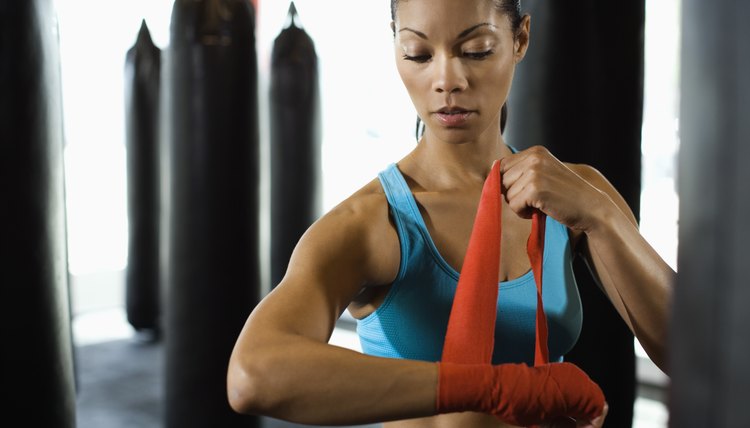Differences Between Muay Thai Bags and Punching Bags

All muay Thai bags are punching bags, but not all punching bags are muay Thai bags. These specialized bags are built to allow athletes who study muay Thai to practice their punches and low kicks with equal facility. To best use this specialized tool, it's important to understand how they are different from the standard heavy bag found in most boxing gyms.
History
Martial arts history is primarily based on oral tradition, and often compromised by myth, legend and political expediency. It's impossible to know for certain how martial arts equipment developed. However, it's a commonly accepted legend that the muay Thai bag evolved out of the practice of kicking and punching coconut trees in ancient Thailand -- a common training technique for muay Thai stylists.
Thai Kick
One move present in muay Thai that's absent from boxing is the Thai kick. This is a powerful roundhouse-type kick delivered to the thigh of an opponent. These kicks are fast, powerful and capable of numbing a target's leg for several minutes, giving the attacking fighter an advantage in the ring. This kick is integral to muay Thai training. A regular punching bag, which hangs only to hip level or so, doesn't allow practice for this kick.
Hanging
Thai bags are significantly longer than regular punching bags. When you hang them, allow the bottom to rest on the floor. The top mount is there to keep it upright, not to support it. This means the bag is at the right level for practicing the Thai kick. When resting that way, the bag will naturally curve like a banana -- an aspect that gives the bag its nickname of "banana bag."
Padding
The padding in heavier, longer punching bags tends to settle into the bottom third of the bag over time. The settled stuffing often times results in a near solid mass. To avoid this type of settling, muay Thai bags are usually made with softer, looser packing. Modern versions will use foam rubber or water-filled cores.
Cost
Muay Thai bags are longer than even 100-pound heavy punching bags. They require more material and often are coated with more durable stuff that can withstand the impact of repeated kicks. This makes them more expensive, usually 150 to 200 percent of the price of a regular 100-pound punching bag of the same brand and quality.
References
- Bill Packer; Kickboxing Coach; Bad Company Fight Team; Albuquerque, New Mexico
- Jason Brick; Martial Arts Teacher; Hillsboro, Oregon
Writer Bio
Beverlee Brick began writing professionally in 2009, contributing to various websites. Prior to this, she wrote curriculum and business papers in four different languages. As a martial arts and group fitness instructor, she has taught exercise classes in North America, Europe and Asia. She holds master's degrees in French literature and education.
